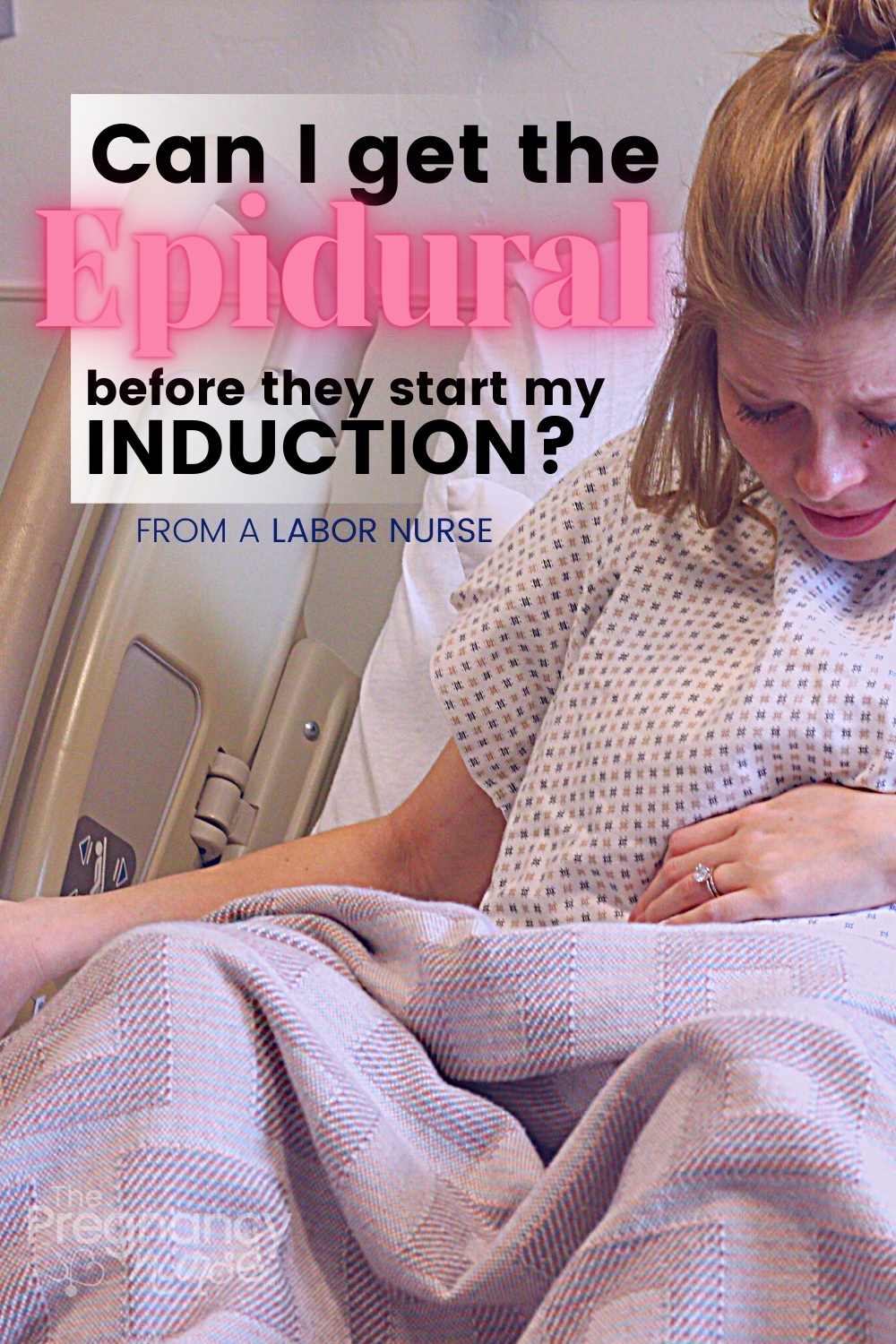👋 I’m so glad YOU are here. Are you looking to also get your partner prepared? This is for BOTH of you. Couples just love it and I know you want to both feel prepared!
Making the choice to get an epidural during an induction can be confusing. If you know you’re going to look for pain relief with an epidural, is there a reason to wait until they actually start your induction?

But first, how do I know all of this? Hi — I’m Hilary — The Pregnancy Nurse 👩⚕️. I have been a nurse since 1997 and I have 20 years of OB nursing experience, I am also the curly head behind Pulling Curls and The Online Prenatal Class for Couples. 🩺 I have started thousands of inductions and I’ve answered questions like this frequently. I’m an expert on when most people prefer to get their epidural, so let do this!
This is part of my Complete Guide to Epidurals — so if you have more questions don’t miss that!
Oh, but before we start — I got over ALL about the epidural and inductions in here. It really is the simple way to get (and feel) prepared for your birth! It can be done in just a few hours, you can get started today!
Can I Get An Epidural Before The Induction?
Yes, I have seen patients given an epidural before we start the induction. But it is complicated.
This is truly up to you and your provider. It also depends on how far along your cervix is and how long the induction is likely to take.
If your cervix is already pretty far along, and you’ve had previous babies. Perhaps they’re just going to come break your water and start some Pitocin, often they will offer the epidural before doing that if you know it is already on your birth plan and you know you want an epidural (some women don’t know and want to wait to see how the pain goes).
For instance, on my last baby I was 6 cm when I went in for my induction — I could have had the epidural at any point.
However, if it is your first baby, and you’re being induced for a medical reason, and your cervix isn’t very favorable they will encourage you NOT to get the epidural early on so that you can still move and have more autonomy during those early induction hours (which may be an extended period of time).
Wondering what a “favorable” cervix is — we talk all about that and your bishop score in here.
When can you get an epidural?
There is one main thing that you need before you get an epidural is a provider’s order (that would come from your midwife or doctor)
Well, and an available anesthesiologist (or nurse anesthetist — those are the people who give the epidural). On some units it can take a bit of time to get an available anesthesiologist, so that is something to know about the culture of your labor unit. You can always ask your nurse “From when I ask for an epidural to when they are available to give me one, how long does that usually take” — that isn’t an unsusual question at all.
In order for a provider to give an order for an epidural they will want to see that you are for sure going to have your baby during this hospital stay. With some elective inductions, they may try a few things for labor — but if your cervix doesn’t open they could send you home (more on that towards the end of this article). So, they obviously would not want you to have the epidural if the labor isn’t working and we think sending you home is the best choice (but I have seen it).
Providers also know the importance of movement and autonomy.
Also, most providers are hesitant to give pain medication if you aren’t actually in pain. Which makes sense, we don’t give you an epidural for a backache — we want to be sure that it is necessary at the time.
When should you ask for an epidural?
First off, you want to clarify with your nurse about how far ahead of time you should make your epidural request. Some hospitals have “lines” for the epidural, and some have anesthesiologists available most of the time (although in any hospital an emergency could delay an epidural).
Beyond that, I always recommend that my patients take labor one contraction at a time. They shouldn’t be afraid of what labor will be — they should decide based on what it is at that time. If they are considering an epidural, and the pain that they are experiencing is enough they should request it. They can then always talk with the anesthesiologist to see if they think it’s best for them.

How late is too late to get an epidural?
If it is your first baby you can most often request an epidural right up til’ you start pushing….
If it is your second baby at about 8 centimeters we start to feel like it probably won’t be able to happen before the baby is born. Simply because you have to sit still for the epidural process and that gets very difficult to do if the baby’s head is starting to come out. You also wouldn’t have time to have the epidural take effect before you had the baby. I have a whole post on if you can get an epidural at 7 cm.
But, you can request an epidural at any time, and then you and your healthcare team can talk about your options.
Pro tip: It is VERY normal at about 8 or 9 centimeters to think you can’t do it and you need pain control. Most often, at that point, it is too late to get the epidural. I talk more about that in my stages of labor bonus video in The Online Prenatal Class for Couples.
How long does it take an epidural to work?
While the time from when you decide to get the epidural til’ anesthesia is available, most often once they are there it takes 20-40minutes for the epidural to be inserted, and then another 15 or so minutes for it to start to numb you. So in total 30 minutes to an hour (from when they get there).
When they come to the room, they will do an informed consent to be sure you understand the risks an the benefits of the epidural.
Then, they will prep your back cleaning it very well. They will numb the area that they will put the needle in. Then, they will insert the needle into the epidural space, and then insert the epidural catheter into this area. The tube is threaded through a mechanical pump that will drip the medicine in at a rate they choose. The tube will remain in so that you can have the medication that will keep your comfortable until the epidural is stopped and removed.
I actually have a whole video of the process (where I do it on a Raggedy Anne Doll, so it’s less intimidating) in here.
When is the Best Time to Get Your Epidural?
I believe the best time to get an epidural is when you progress into active labor. For me, that means you’re past 3-4 centimeters and your cervix is actively opening (meaning, when they check you an hour later your cervix has progressed from the previous check).
Personally, I believe that gives you the opportunity to move more and get baby best engaged in your pelvis before you have a nice nap post-epidural.
In my personal 20-years of experience I felt like moms who got the epidural before 3 centimeters tended to have cesarean sections more often than those who didn’t). Of course, that could be that they were experiencing more pain because baby just wasn’t positioned well, or was too big etc — perhaps that’s just an indicator that she isn’t likely to be able to have a vaginal birth — not that it was caused by the epidural
BUT, the studies have really shown that it’s just best to get it when the mom wants it. So, I would take all that information and use it as you’d prefer. I have a whole post on when the best time to get the epidural is.
What is induced labor?
It is when you aren’t in labor, and we start your labor with either medicinal (like pitocin) or mechanical methods (like breaking your water or inserting a foley bulb) into your cervix).
I do have a super short class on inductions if you have a lot of just-induction questions.
What are the differences between an induced and a natural labor?
Many women believe that induced labor is more painful than natural labor.
I have both had natural labor and induced labor. For me, I felt like the pain was pretty similar. BUT I was stuck in a bed at the hospital with my induction. I wasn’t able to do things around my house or nap in my own bed — I was just stuck there. It made the whole experience less-fun…. and probably felt a bit more painful.
The arrive trial (so controversial — but I have a whole video just on that in the induction chapter in here) showed that the women who had an induction actually rated their pain less than women who went into labor naturally. No study is perfect, but I thought that was interesting.

Oxytocin vs Pitocin
Most inductions are done using Pitocin (which is the synthetic form of oxytocin). While the chemicals are 100% the same, Oxytocin is released by your brain and does cause some positive affects to your mood when it is released. Pitocin is unable to reach your brain because we inject it into your veins and it does not cross the blood brain barrier. I thought that was an interesting piece of information.
Can I decide whether to have an induced labor?
You sure can. No doctor is going to drive to your house and pick you up for your induction. It’s very much up to you.
Your doctor should give you informed consent about your induction and then you can make the choice that is best for you. Things to consider:
- How many cm dilated you are — what is your cervical exam — if your cervix is still closed it will likely take longer.
- What are the medical reasons you NEED to be induced
- What are the other reasons you want/need to be induced
If an induction isn’t medically necessary it’s called an “elective induction” — and those are not offered until 39 weeks.
Can I have pain relief during induced labour?
Yes, all the pain management options are available to those being induced. Those include:
- IV pain medicine
- Nitrous oxide (if available at your hospital)
- Epidural
And obviously, you can use all the natural pain management methods with an induction. It is just not quite as easy as the baby will need to remain monitored the whole time for safety reasons.
A lot of people ignore natural pain management if they’re planning on an epidural, and I think that can be a mistake. I encourage ALL couples to watch my natural pain management bonus video in The Online Prenatal Class for Couples — because you just never know.
What happens if the induction does not work?
Well, if you are being induced for a medical reason, they will look at the reasoning and decide if it is worth having a cesarean section. If you have high blood pressure that is just increasing, or if baby has any issues growing or thriving in the womb this may be your safest option. But, be aware that option is ALWAYS up to you. Make sure that you remember that.
If you are being induced electively, they may encourage you to go home. Some providers may also give you the option to have a cesarean section. Either way, the choice will be yours. Although, they may not allow you to stay and continue inducing you as that may not be safe for you or the baby.
So, I hope this answered your question about if you can get the epidural before they start your induction. I’ve had a few friends get this method and they absolutely love it. So, I hope you make the best choice for yourself.
Come get prepared with me in The Online Prenatal Class for Couples where we talk more about the risks and the benefits of the choices you make during labor (and how to communicate better with your healthcare team!).
Have you checked a birth class off your to do list✅? I have a few I recommend:
❤️ Best class for couples {per BabyList}
👩💻 Best class available on demand
⚡ Best class JUST for pain management
👶 Best Postpartum-Only Prep
❤️🧡💛💚💙💜 My favorite class is here.
Now is the time to get started!
And, if you’re not quite sure you’re ready for that whole thing, check out my free prenatal class. It’s your first step toward getting in the driver’s seat of your birth.






 What Happens if You’re Sent Home From the Hospital in Early Labor?
What Happens if You’re Sent Home From the Hospital in Early Labor?
